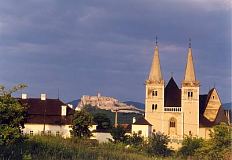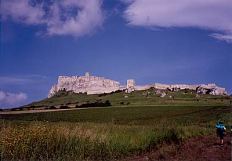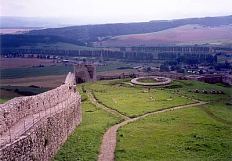Spiš castle, Spišská Kapitula and surroundings
 Spišská Kapitula - a town memorial reservation. Its history reaches back to
the 11th century, when on the place of a former Benedictine monastery a small
settlement arose. Later a priory was established there. In the 13th century
it was surrounded by defense walls. In 1776 Spišská Kapitula
became the seat of the bishop. The most important building of the town is
the St.Martin's cathedral from the 13th century with a gothic
Zápoľský chapel. Other interesting buildings are -
the Bishop's palace, Clock tower, seminar and several "kanonias" (houses of the
kanoniks - the Bishop's advisors).
Spišská Kapitula - a town memorial reservation. Its history reaches back to
the 11th century, when on the place of a former Benedictine monastery a small
settlement arose. Later a priory was established there. In the 13th century
it was surrounded by defense walls. In 1776 Spišská Kapitula
became the seat of the bishop. The most important building of the town is
the St.Martin's cathedral from the 13th century with a gothic
Zápoľský chapel. Other interesting buildings are -
the Bishop's palace, Clock tower, seminar and several "kanonias" (houses of the
kanoniks - the Bishop's advisors).
Spiš castle - The National Cultural Monument Spiš castle together with Spišská Kapitula and church in Žehra) have been included in the list of World Cultural Heritage of UNESCO. It's one of the largest castles in the central Europe (covers 4 ha). The oldest written record dates from the 12th century. At the beginning it was a border stronghold, later it became a seat of župan (head of the region). The largest reconstruction was made by the owner Zápoľský (also the castle in Kežmarok belonged him) - the palace, and also the St. Elisabeth chapel were built. The last owner was the Csáky family - in 1780 the castle burned down. In 1970 a difficult reconstruction has begun. Today the castle is open to public with expositions of history, medieval weapons and feudal justice; also with a large castle yard.
Other sights in the Spiš castle territory - in the area just a few kilometers around the Spiš castle we can find another interesting places. The most interesting one is the village Žehra with it's the Holy Spirit church (also belonging to the UNESCO's list). The church was made of the Spiš travertine in 1245. Its today's appearance is a slight combination of two styles - the Roman and the Gothic. The vaults are from 1433, a baroque tower dates from the 18th century. In the interior there are very valuable wall paintings from the 13th - 15th century. The altar is from 1656.
Other villages in the surroundings are also worth of visitors' interest - in the village Hodkovce it is a manor house of the Csáky family (the last owners of the Spiš castle). In Bijacovce it is a very valuable Roman rotunda and a church from before 1260 (the interior wall paintings from the 14th century are considered to be the nicest in Slovakia). In Bijacovce there is also another manor house of the Csákys. The Natural reservation named Dreveník also cannot be left out. This hill is the biggest travertine mass in Slovakia - thickness of travertine reaches almost 100m. The Hell (Peklo) - one of the nicest valleys and the Stone town can be seen going through the path Sivá, Brada - Dreveník, which ends in Žehra.

